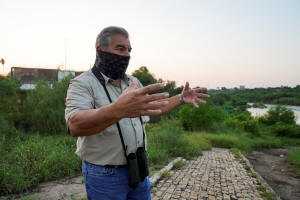Strange bedfellows: Laredo's millionaires, nuns and muralists battle
border wall
 Send a link to a friend
Send a link to a friend
 [October 05, 2020]
By Laura Gottesdiener [October 05, 2020]
By Laura Gottesdiener
LAREDO, Texas - Former U.S. Border Patrol
agent Daniel Perales spent hours over the years crouched at the mouth of
the Zacata Creek, a tributary of the Rio Grande, listening for the snap
of carrizo cane as border crossers from Mexico arrived on the northern
banks.
These days, he listens for the whistle of the Morelet's seedeater, a
bird rare in these parts, and frets about the proposed construction of a
border wall here.
"It would fragment the habitat of the birds, especially those that live
along the river," said Perales, who spent nearly 30 years with the
federal agency and oversaw 400 agents at the Laredo North Station before
retiring in 2007.
Perales said he voted for President Donald Trump in 2016 and plans to do
so again. But that hasn't stopped him from joining the ranks of
residents in Laredo opposed to building a barrier here as part of
Trump's promised wall spanning the U.S.-Mexico border.
"It's not necessary. You don't need a wall here," said Perales, adding
that cameras and patrol roads were sufficient.

Less than a month before the U.S. presidential election, resistance to
the wall, a centerpiece of Trump's 2016 campaign, is flaring across
parts of the approximately 2,000-mile border. Near construction sites in
Arizona and California in recent weeks, members of Native American
tribes have clashed with law enforcement and others over plans for
building on lands the tribes consider sacred. Two weeks ago in front of
a Laredo courthouse, military veterans against the border project
mobilized to thwart a caravan of Trump supporters who had sought to
drive over a 30-foot "Defund the Wall" street mural.
Amid an election upended by Trump's positive coronavirus diagnosis, the
future of the wall hangs in the balance. Trump's Democratic challenger,
former vice president Joe Biden, has said he would not build "another
foot of wall" if elected.
Meanwhile, opposition to plans for a stretch of wall in the counties of
Zapata and Webb, which includes Laredo, has united some strange
bedfellows: the street artists, multimillionaire Republicans, Catholic
nuns, military and border patrol veterans, conservationists and a local
Native American tribe.
In Webb County, CBP has issued contracts worth $1.05 billion to three
construction companies to build approximately 69 miles of a 30-foot
steel bollard wall, as well as construct roads and adding cameras and
other surveillance technology.
Construction is slated to begin as early as January depending on the
availability of land.
In an August press release, CBP officials said the Laredo wall is
necessary to "impede and deny illegal border crossings and the drug and
human smuggling activities of transnational criminal organizations." In
the Laredo sector, traffic has not abated during the coronavirus
pandemic as it has in other sectors, government data show.
In statements to Reuters, CBP spokesman Matthew Dyman said the agency is
committed to protecting cultural and natural resources, such as wildlife
corridors and culturally sensitive Native American artifacts or sites.
The agency is now surveying land for possible purchase. Dyman said it is
"always CBP's preference" to obtain land voluntarily through negotiated
offers but if that is not possible, a condemnation action - known as
eminent domain - may be required.
The majority of Americans oppose a substantial expansion of the border
wall, according to a January 2019 Pew research poll, although the
opinions tended to fall along party lines, with 82% of Republicans in
favor and 93% of Democrats opposed.
Opposition in Laredo, which is predominantly Democrat but contains a
substantial Republican contingent, appears more lopsided. More than two
dozen cities, counties, and Native American tribes in the border region
have passed resolutions opposing the project, including Laredo in 2017.
DECLARING INDEPENDENCE - AGAIN
A city of 262,000, Laredo sits in a former Spanish colony and Mexican
territory, hugging the Rio Grande River. Here, partisan political
divisions quickly evaporate when it comes to deciding on boundaries and
the fate of the land.
Webb County is 95% Hispanic and many residents have family connections
to Mexico. Business owners depend on cross-border trade. Some ranchers
trace their property rights back to the 18th century Spanish land
grants. The ancestors of the Carrizo/Comecrudo Tribe of Texas formed
their ties to the territory well before then.
In 1840, Laredo was the seat of the short-lived Republic of the Rio
Grande, whose independence from Mexico lasted for 10 months before its
cavalry was crushed by that country's Army.
"We've declared independence before — and we could do it again," said
Margarita Araiza, executive director of the Webb County Heritage
Foundation who traces her family's roots in Laredo back twelve
generations to that 19th-century rebellion.
[to top of second column]
|

Daniel Perales, birder and president of Monte Mucho Audubon Society
Chapter, who is a retired border patrol agent and opposes the border
wall, talks about he impact of it yards away from the Rio Grande in
Laredo, Texas, U.S., September 19, 2020. REUTERS/Veronica G.
Cardenas

She worried the wall's construction could destroy or destabilize the
city's 250-year-old historic sandstone buildings and sever its cozy
relationship to the Rio Grande, where residents often fish, picnic,
and stroll.
"This is the reason this city was created, because of access to the
river," said Araiza.
CBP spokesman Dyman said that no historic buildings would be
directly affected by border wall construction based on current
plans.
Araiza is one of the founding members of the Laredo No Border Wall
Coalition, a loosely organized group that seeks to halt the project.
Working with a coalition of concerned landowners is the Laredo-based
IBC Bank, whose chief executive officer, Dennis Nixon, was a top
Trump donor in 2016. The proposed barrier could cut through the
bank's 75 acres of waterfront property.
"At a time when (America’s) number one trading partner is Mexico,
what is the message we are sending to our friends in Mexico?" said
Gerardo Schwebel, executive vice president of the bank's corporate
international division.
Not everyone in the city is opposed to the barrier. Supporters say
the Mexican town of Nuevo Laredo, just across the river, is a hub
for drug trafficking and human smuggling.
"No one wants to build a wall around their homes if they don't have
to, but there's a need for that security," said Hector Garza,
president of the National Border Patrol Council's local union
chapter.

‘A BETTER WAY’?
The proposed border wall in Texas primarily cuts through private
land, generating opposition and some alliances among occupants and
landowners large and small.
Felipe Antonio Perez, a 92-year-old retired carpenter, said he'd
lived in his modest wooden house near the river bank in Laredo's
historic La Azteca neighborhood for over sixty years. Standing
beside a "No Border Wall" sign on his fence, he told Reuters he'd
thrown away a government inquiry about surveying his land.
The oil-rich Fasken family, one of the top-fifty largest landowners
in the United States with 85,000 acres in Webb County alone,
co-founded the Rio Grande Landowners' Coalition to stop the wall
project.
"We feel there is a better way to secure the border and that putting
up a 30-foot high wall to make a political statement is not the best
use of taxpayers' money," said Bill Skeen, the family's real estate
manager.
Also opposed are the sisters of the century-old Sacred Heart
Children's Home for orphans, which overlooks the river.
"Put yourself in the place of an individual who has been orphaned -
abandoned, abused, or whose parents have died -- the land and its
natural beauty and its view becomes your refuge," said Beto
Cardenas, the attorney representing the sisters in their
negotiations with the government.
The ancestral territory of the Carrizo/Comecrudo Tribe of Texas
extends on both sides of the river, said Chairman Juan Mancias as he
surveyed riverside willow trees that the tribe uses to build sweat
lodges on ranch land outside Laredo. Native burial grounds lie along
the river, he said.
"The wall is a racial attack on our identity as people of the land,"
he said.
He said the tribe does not own riverfront land - it "owns us." But
his people are committed to protecting it.
"My great grandchildren would be denied this," he said, looking
across the landscape dotted with mesquite trees and purple sage.
"They would be denied who they are."
(Laura Gottesdiener reported from Laredo, Texas. Editing by Frank
Jack Daniel and Julie Marquis)
[© 2020 Thomson Reuters. All rights
reserved.] Copyright 2020 Reuters. All rights reserved. This material may not be published,
broadcast, rewritten or redistributed.
Thompson Reuters is solely responsible for this content. |